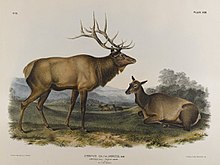Eastern elk
| Eastern elk | |
|---|---|
 |
|
| Illustration of the extinct red deer subspecies Cervus elaphus canadensis, John James Audubon 1847 | |
| Scientific classification | |
| Kingdom: | Animalia |
| Phylum: | Chordata |
| Class: | Mammalia |
| Order: | Artiodactyla |
| Family: | Cervidae |
| Subfamily: | Cervinae |
| Genus: | Cervus |
| Species: | C. canadensis |
| Subspecies: | †C. c. canadensis |
| Trinomial name | |
|
Cervus canadensis canadensis |
|
The eastern elk (Cervus canadensis canadensis) was one of six subspecies of elk that inhabited the northern and eastern United States, and southern Canada. The last eastern elk was shot in Pennsylvania on September 1, 1877. The subspecies was declared extinct by the United States Fish and Wildlife Service in 1880. Another subspecies of elk, the Merriam's elk, also became extinct at roughly the same time.
The eastern elk was larger than its western cousins. A full-grown bull could weigh up to 1000 pounds, stand 50-60 inches tall at the shoulder, and carry a rack of antlers six feet in length.
By the late 15th century, elk were the most widespread in the New World and could be found throughout most of North America. Eastern elk inhabited the vast forests of eastern Canada and the eastern United States as far west as the Mississippi River. As people continued to settle in the region over the next few centuries, elk populations decreased due to over-hunting and the loss of their dense woodland habitat. Naturalist John James Audubon reportedly mentioned that by 1851 a few elk could still be found in the Allegheny Mountains but that they were virtually gone from the remainder of their range. By the end of the 19th century the Eastern elk was completely extinct. What little is known about this race of elk has been gleaned from remains and historical references. Mitochondrial DNA studies in 2004 indicate that Cervus canadensis are a species distinct from European red deer.
Not long after the last elk was killed in Pennsylvania, federal officials, worried about mushrooming elk herds in and around Yellowstone National Park, offered the animals to anyone willing to take them. The recently formed Pennsylvania Game Commission took Yellowstone officials up on their offer, and launched a program to reintroduce elk to Pennsylvania. Starting in 1913 and ending in 1926, the Commission released 177 elk in 10 counties, including 50 animals from Yellowstone. Currently, Pennsylvania's elk herd numbers more than 800 and their range covers approximately 800 square miles.
...
Wikipedia

